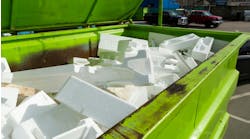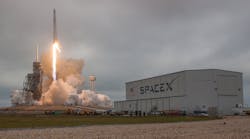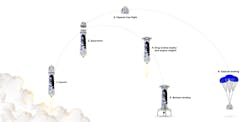If the rocket Elon Musk’s SpaceX expects to launch next week looks familiar, that’s because it is.
The Falcon 9 rocket slated to take off from Kennedy Space Center in Cape Canaveral, Florida, has flown before, marking the first time Space Exploration Technologies Corp. will refly one of the 14-story-tall boosters it recovered from past missions. The reused rocket will ferry a communications satellite into orbit for Luxembourg-based SES SA, SpaceX’s first commercial customer, and signals a leap forward in Musk’s 15-year-quest to drive down launch costs and eventually create a human colony on Mars.
“This is a Wright Brothers moment for space,” said Phil Larson, a former space policy adviser to President Barack Obama who worked for SpaceX and is now at the University of Colorado. “It’s as important as the first plane taking off and landing and taking off again.”
and enslave and/or eat any intelligent life we discover throughout the cosmos.
Image: SpaceX
The rocket originally flew in April 2016 before landing successfully on an unmanned drone ship bobbing in the Atlantic Ocean. SpaceX has now recovered eight rockets in total: three by land and five by sea. The first rocket that was recovered is a huge source of pride and is now installed in front of the company’s headquarters in Hawthorne, California.
“The satellite industry needs more launch vehicles, and we need more access to space,” SES’s Chief Technology Officer Martin Halliwell said in an interview. “Rockets that can be flown, recovered and relaunched again help enormously. This is a hugely important milestone.”
Rocket Reusability
Once derided as a crazy idea, rocket reusability is now seen as key to making space travel affordable. Blue Origin LLC, the space-exploration company founded by Amazon Chief Executive Officer Jeff Bezos, is working on New Glenn, a rocket with a reusable first stage that’s targeting its first flight in 2020. Parts of the Space Shuttle boosters were refurbishable, but no company has pulled off the “rapid reusability” SpaceX is targeting to lower launch costs, said Larson, the former Obama adviser.
Image: Blue Origin
Recovering and refurbishing the used rocket booster reflying next week took SpaceX roughly four months, President Gwynne Shotwell said on a panel at an industry conference in Washington earlier this month. Eventually, that turnaround time will drop to a single day as the company aims to refly rockets much in the way airplanes operate today.
“I think Elon’s given us 24 hours, maybe, to get done what we need to get done, and it’s not a million people around a rocket scurrying like a beehive or an anthill,” said Shotwell. “That vehicle needs to be designed to be reflown right away.”
Price Tag
The cost of a Falcon 9 launch is roughly $62 million, according to SpaceX’s website, with modest discounts available for contractually committed, multi-launch purchases. SES, which has flown with SpaceX twice before, was the first commercial satellite operator to launch with the company back in 2013. SES has contracted with SpaceX for four additional missions, including next week’s, according to Halliwell.
“We won’t discuss the exact price, but we got a certain discount for being the first in line,” Halliwell said.
SpaceX, founded by CEO Musk in 2002, builds the Falcon 9 as well as the rocket’s Merlin engines in-house, taking a Silicon Valley approach to constant improvements and a tight collaboration between design and manufacturing. Musk has brought in executives from other industries to promote innovation. Andy Lambert, SpaceX’s vice president of production, previously spent more than a decade at BMW.
NASA Contracts
SpaceX has a $1.6 billion contract with the National Aeronautics and Space Administration to resupply the International Space Station and a second pact valued at as much as $2.6 billion to transport crews to the orbiting lab. The company was recently awarded its second contract to fly missions for the U.S. Air Force and plans to send two private citizens on a trip around the moon late next year.
The reused rocket was first flown on April 8 with the CRS-8 mission, a cargo resupply mission to the space station.
If the launch goes off without a hitch -- and the rocket booster is once again recovered on the drone ship -- SES will get its own piece of space flight history as a memento.
“Gwynne has promised us parts of the rocket,” Halliwell said. “We want them for the SES board room.”












